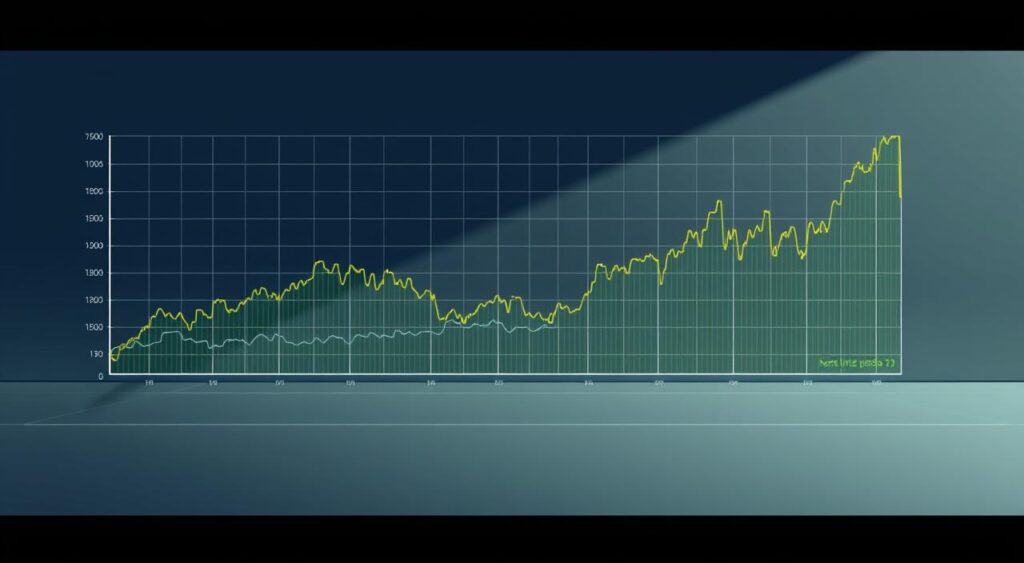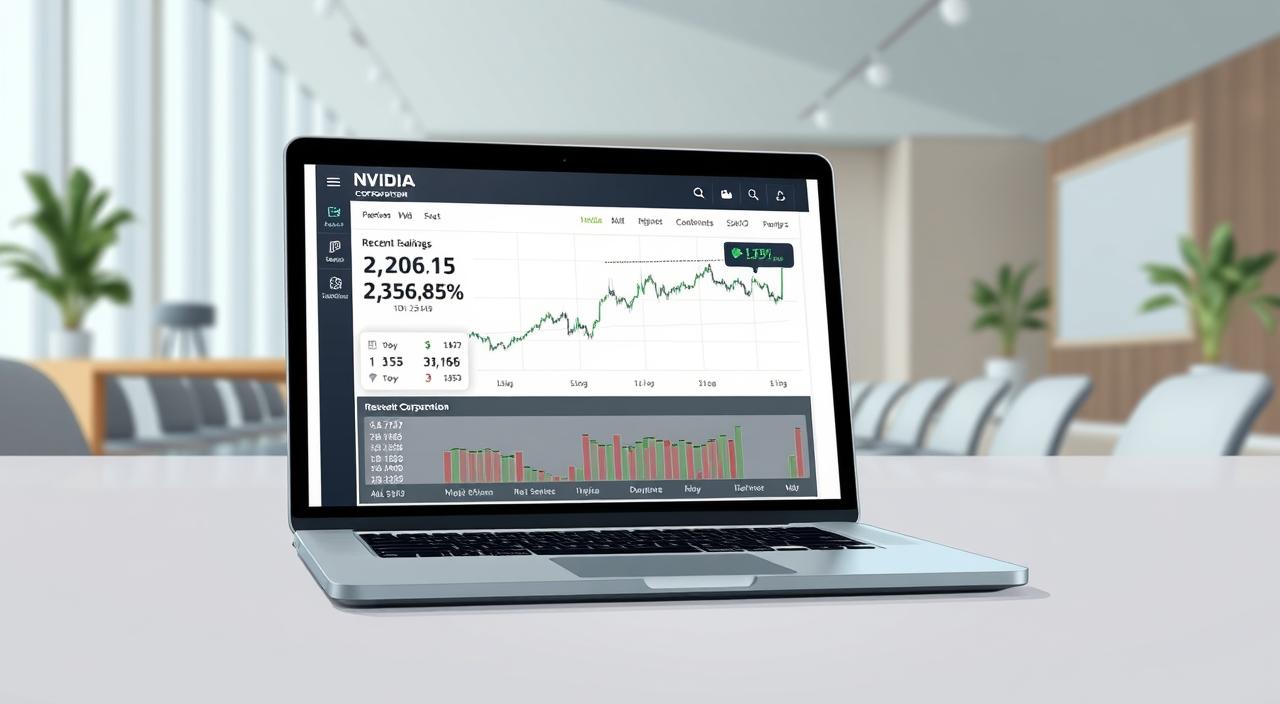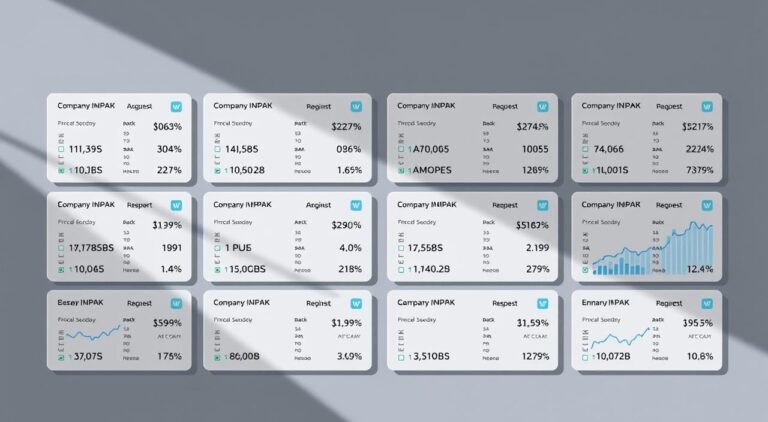Nvidia Stock Analysis After Recent Earnings
Nvidia continues to assert itself as a dominant force in the semiconductor sector, leveraging advancements in technology and artificial intelligence (AI) to drive growth. The recent earnings report serves as a pivotal moment for investors and stakeholders, providing a comprehensive Nvidia quarterly earnings review that highlights the company’s financial acumen and market positioning. As we delve into this Nvidia financial analysis post earnings, it’s essential to note that current analyst price targets sit around $162, suggesting significant upside potential, nearly 20% over its current price. Historical trends indicate that Nvidia stock often rebounds effectively following earnings releases, making this stock performance evaluation critical for investors who are keen on capitalizing on market fluctuations.
Key Takeaways
- Nvidia’s recent earnings report demonstrates solid financial health.
- Analyst targets suggest a potential upside of nearly 20% from current levels.
- Historical data indicates a positive stock rebound post-earnings.
- The semiconductor sector remains a competitive landscape.
- Stakeholder sentiment is cautiously optimistic for future growth.
Overview of Nvidia’s Recent Earnings Report
Nvidia’s latest earnings report reveals impressive financial performance, reflecting strong growth potential within the tech industry. This Nvidia earnings report analysis highlights significant advancements in key financial metrics, which are essential for investors assessing the company’s stature in various sectors.
Key Financial Metrics
The earnings report indicates that Nvidia recorded a remarkable revenue of $441 billion, marking a significant year-over-year growth of 69%. Their net profit stood at $188 billion, representing a 26% increase. Additionally, the adjusted earnings per share (EPS) were reported at $0.96, exceeding analyst expectations of $0.93, reinforcing the positive Nvidia financial analysis post earnings.
Revenue Breakdown by Sector
A detailed review of the revenue breakdown reveals which sectors contribute significantly to Nvidia’s growth. The company’s performance in artificial intelligence and gaming, in particular, underscores its diversified revenue streams. Investors will find this information invaluable as it directly relates to the Nvidia stock outlook analysis.
Comparison to Analyst Expectations
The earnings report illustrates that Nvidia not only met but surpassed many analyst expectations. This performance strengthens investor confidence, as various comparisons against prior forecasts show an upward trend. Understanding these dynamics will guide stakeholders in making informed decisions about Nvidia’s future.
Market Reaction to Earnings Report
Nvidia’s recent earnings report sparked notable reactions in the stock market. Following the announcement, investors witnessed significant stock price movements that highlighted the company’s strong financial performance amidst a turbulent market environment.
Immediate Stock Price Changes
In post-market trading, Nvidia’s stock soared by over 5%. This surge illustrated a robust Nvidia stock performance evaluation, clearly reflecting investor confidence. Despite broader market sell-offs affecting major indices, Nvidia’s impressive financial results attracted renewed attention. Analysts believe this trend may influence future Nvidia stock price predictions as the company continues to demonstrate its potential for sustained growth.
Investor Sentiment Analysis
Investor sentiment surrounding Nvidia has revealed a noteworthy optimism. Fueled by their ability to surpass profit expectations, the company’s resilience shines through even as other technology stocks encounter complications. This contrasting outlook underscores the Nvidia earnings impact on stock valuation, positioning the company favorably among investors seeking reliable growth opportunities.
Analysis of Nvidia’s Growth Prospects
Nvidia stands at the forefront of technological advancement, particularly in the domains of AI and machine learning. The company’s innovative solutions, especially their Blackwell GPUs, cater to soaring demands in these fields, highlighting their pivotal role in shaping future applications. This momentum forms a critical part of the Nvidia stock forecast, suggesting continued upward potential.
Equally important is Nvidia’s substantial impact on the gaming industry. This sector has embraced Nvidia’s advanced technologies, enriching user experiences and setting new standards for performance. Analysts are closely monitoring this aspect in their Nvidia earnings report analysis, as it could significantly enhance revenue streams moving forward.
The data center segment also reveals promising growth trends. As more organizations shift operations to the cloud, Nvidia’s technology becomes increasingly indispensable. This trend solidifies Nvidia’s market position and drives the overall narrative of an optimistic Nvidia stock outlook analysis. Investors should note these elements as they shape long-term profitability for the company.
Competitive Landscape
Nvidia operates within a highly competitive landscape, with strong rivals such as AMD and Intel challenging its dominance in the semiconductor and artificial intelligence markets. As market dynamics evolve, understanding these competitors becomes essential for a thorough Nvidia stock analysis after recent earnings.
Key Competitors in the Industry
- AMD: Specializes in high-performance computing products and has gained significant ground in GPU technology.
- Intel: Renowned for its microprocessors, Intel is investing heavily in AI initiatives to keep pace with Nvidia.
- Qualcomm: Competes in the mobile segment, focusing on AI capabilities for smartphones and other devices.
Nvidia’s Market Position and Strengths
Nvidia’s market position reflects its historical strength in producing graphics processing units (GPUs) that power gaming and AI applications. Its continuous innovation enables the company to maintain a leadership role in the rapidly evolving tech environment. The Nvidia financial analysis post earnings reveals a commitment to R&D and a robust product pipeline that strengthens its unique advantages. This influence on Nvidia stock performance evaluation shows that the company’s strategic initiatives continue to foster a competitive edge against its rivals.

Challenges Facing Nvidia
Even with impressive earnings reports, Nvidia must navigate several challenges that could affect its future stock performance. Two prominent factors are supply chain disruptions and regulatory risks, which could hinder the company’s growth and overall profitability.
Supply Chain Issues
Nvidia’s reliance on a global supply chain places it at risk of delays and shortages. Ongoing supply chain challenges in the tech industry may impede the company’s ability to produce and deliver products at the rate necessary to satisfy increasing demand. These disruptions could have a significant impact on the Nvidia stock forecast, leading investors to reassess Nvidia stock price predictions as the company struggles to maintain its market position.
Regulatory Risks
The technology sector faces heightened scrutiny concerning data privacy and antitrust regulations. Nvidia is not immune to these pressures, as investigations may lead to significant operational changes or penalties. Such regulatory hurdles can adversely affect Nvidia earnings impact on stock valuation, leading to increased volatility in its stock and influencing long-term investor confidence.
Long-Term Investment Considerations
Investors examining Nvidia’s long-term prospects will find notable insights within the historical performance data linked to the company’s earnings. Historical trends point towards substantial gains following earnings reports, demonstrating a robust potential for appreciation. The Nvidia quarterly earnings review illustrates how patient investors can reap significant rewards, as Nvidia’s stock has shown impressive returns over recent years.
Historical Performance Overview
A thorough analysis of the past performance reveals that Nvidia has consistently outperformed the market, especially after earnings announcements. Many investors have witnessed stock price surges exceeding 100% as Nvidia capitalizes on its innovative technologies and industry leadership. This Nvidia stock analysis after recent earnings highlights how critical it is for investors to understand the company’s trajectory when considering their strategies.
Dividends and Share Buybacks
Nvidia’s approach to enhancing shareholder value continues to attract attention. The company’s initiatives regarding share buybacks and dividends stand as compelling factors for long-term investment considerations. Such strategies not only serve to reward loyal investors but also underline Nvidia’s commitment to maintaining a solid financial position. As seen in Nvidia financial analysis post earnings, these measures may appeal to those looking for income while investing in a growth-oriented technology firm. For investors interested in ways to enhance their portfolios, exploring further opportunities may be worthwhile. You can investigate options here.

Analyst Recommendations
Investor sentiment surrounding Nvidia reflects a spectrum of perspectives. Analysts have compiled varied insights based on the recent Nvidia earnings report analysis. Some analysts express a bullish outlook, citing the company’s robust financial results and promising growth potential in sectors like AI and gaming.
Bullish vs. Bearish Perspectives
Those with bullish views argue that Nvidia’s advancements position the company for significant gains. They emphasize:
- Increasing demand for GPUs across various industries.
- Ongoing innovations that could drive future revenue.
Conversely, bearish analysts raise concerns over potential obstacles. Issues such as economic fluctuations and tough competition could impact Nvidia’s long-term profitability. This nuanced analysis provides a balanced view on the stock’s outlook.
Price Target Projections
According to current analyses, the average price target for Nvidia stock stands at approximately $162. This figure suggests considerable upside potential based on today’s trading levels. Investors should closely monitor these forecasts as part of their Nvidia stock outlook analysis, factoring them into their investment strategies. Overall, understanding the Nvidia stock price prediction landscape offers a critical lens for decision-making in this dynamic market.
Conclusion: Is Nvidia Stock a Buy?
In evaluating Nvidia stock analysis after recent earnings, it’s clear that the company stands on solid ground. With earnings that not only met but exceeded analyst expectations, coupled with notable growth in sectors such as artificial intelligence and data centers, the outlook appears optimistic. The company has demonstrated resilience and innovation, marking its position as a leader in the tech space.
Summary of Findings
Nvidia’s financial analysis post earnings highlights a robust financial trajectory, reinforcing investor confidence. Despite potential challenges including supply chain disruptions and regulatory scrutiny, the overall sentiment around Nvidia stock remains bullish. The focus on strategic growth initiatives and consistent performance in key markets helps mitigate these risks and fosters a favorable environment for prospective investors.
Final Thought on Investment Strategies
As the market continues to evolve, Nvidia’s stock price prediction suggests that there is significant upside potential. Investors are encouraged to consider well-timed entry points to maximize returns, taking into account both the risks and the company’s historical strengths. Keeping a close watch on developments in the tech industry and Nvidia’s response to challenges will be crucial in forming a sound investment strategy moving forward.
FAQ
What were Nvidia’s key financial metrics in the recent earnings report?
FAQ
What were Nvidia’s key financial metrics in the recent earnings report?
Nvidia reported revenue of 1 billion, representing a staggering 69% year-over-year growth. Their net profit reached 8 billion, marking a 26% increase, while adjusted earnings per share (EPS) was reported at
FAQ
What were Nvidia’s key financial metrics in the recent earnings report?
Nvidia reported revenue of $441 billion, representing a staggering 69% year-over-year growth. Their net profit reached $188 billion, marking a 26% increase, while adjusted earnings per share (EPS) was reported at $0.96, exceeding analyst expectations of $0.93.
How did Nvidia’s earnings impact its stock price?
Following the earnings report, Nvidia’s stock experienced significant volatility, surging over 5% in post-market trading due to the strong financial outcomes, despite broader market sell-offs affecting major indices.
What are the main growth drivers for Nvidia?
The primary growth drivers for Nvidia include substantial advancements in AI and machine learning technologies, a significant demand for their Blackwell GPUs, and an expanding presence in the gaming industry while showing promising growth in the data center segment.
Who are Nvidia’s main competitors in the semiconductor industry?
Nvidia faces tough competition from companies like AMD and Intel, particularly in the semiconductor and AI markets. However, Nvidia has maintained a robust market position through continuous innovation and exceptional performance in AI-driven solutions.
What challenges does Nvidia currently face?
Nvidia encounters challenges such as persistent supply chain disruptions that could limit its ability to meet rising demand. Additionally, regulatory risks related to data privacy and antitrust inquiries pose threats to its operational framework.
What should investors consider when evaluating Nvidia’s long-term investment potential?
When evaluating Nvidia’s long-term prospects, investors should analyze its historical performance, which shows significant gains post-earnings, strategies in share buybacks, and dividends while also considering the risks posed by supply chain issues and regulatory scrutiny.
What are analysts’ sentiments regarding Nvidia’s stock?
Analysts display varied sentiments towards Nvidia, with many holding bullish perspectives due to strong financial performance and growth potential. Conversely, some bear caution regarding macroeconomic factors and competition while the average analyst price target is around $162, indicating substantial upside potential from current levels.
FAQ
What were Nvidia’s key financial metrics in the recent earnings report?
Nvidia reported revenue of 1 billion, representing a staggering 69% year-over-year growth. Their net profit reached 8 billion, marking a 26% increase, while adjusted earnings per share (EPS) was reported at
FAQ
What were Nvidia’s key financial metrics in the recent earnings report?
Nvidia reported revenue of $441 billion, representing a staggering 69% year-over-year growth. Their net profit reached $188 billion, marking a 26% increase, while adjusted earnings per share (EPS) was reported at $0.96, exceeding analyst expectations of $0.93.
How did Nvidia’s earnings impact its stock price?
Following the earnings report, Nvidia’s stock experienced significant volatility, surging over 5% in post-market trading due to the strong financial outcomes, despite broader market sell-offs affecting major indices.
What are the main growth drivers for Nvidia?
The primary growth drivers for Nvidia include substantial advancements in AI and machine learning technologies, a significant demand for their Blackwell GPUs, and an expanding presence in the gaming industry while showing promising growth in the data center segment.
Who are Nvidia’s main competitors in the semiconductor industry?
Nvidia faces tough competition from companies like AMD and Intel, particularly in the semiconductor and AI markets. However, Nvidia has maintained a robust market position through continuous innovation and exceptional performance in AI-driven solutions.
What challenges does Nvidia currently face?
Nvidia encounters challenges such as persistent supply chain disruptions that could limit its ability to meet rising demand. Additionally, regulatory risks related to data privacy and antitrust inquiries pose threats to its operational framework.
What should investors consider when evaluating Nvidia’s long-term investment potential?
When evaluating Nvidia’s long-term prospects, investors should analyze its historical performance, which shows significant gains post-earnings, strategies in share buybacks, and dividends while also considering the risks posed by supply chain issues and regulatory scrutiny.
What are analysts’ sentiments regarding Nvidia’s stock?
Analysts display varied sentiments towards Nvidia, with many holding bullish perspectives due to strong financial performance and growth potential. Conversely, some bear caution regarding macroeconomic factors and competition while the average analyst price target is around $162, indicating substantial upside potential from current levels.
.96, exceeding analyst expectations of
FAQ
What were Nvidia’s key financial metrics in the recent earnings report?
Nvidia reported revenue of $441 billion, representing a staggering 69% year-over-year growth. Their net profit reached $188 billion, marking a 26% increase, while adjusted earnings per share (EPS) was reported at $0.96, exceeding analyst expectations of $0.93.
How did Nvidia’s earnings impact its stock price?
Following the earnings report, Nvidia’s stock experienced significant volatility, surging over 5% in post-market trading due to the strong financial outcomes, despite broader market sell-offs affecting major indices.
What are the main growth drivers for Nvidia?
The primary growth drivers for Nvidia include substantial advancements in AI and machine learning technologies, a significant demand for their Blackwell GPUs, and an expanding presence in the gaming industry while showing promising growth in the data center segment.
Who are Nvidia’s main competitors in the semiconductor industry?
Nvidia faces tough competition from companies like AMD and Intel, particularly in the semiconductor and AI markets. However, Nvidia has maintained a robust market position through continuous innovation and exceptional performance in AI-driven solutions.
What challenges does Nvidia currently face?
Nvidia encounters challenges such as persistent supply chain disruptions that could limit its ability to meet rising demand. Additionally, regulatory risks related to data privacy and antitrust inquiries pose threats to its operational framework.
What should investors consider when evaluating Nvidia’s long-term investment potential?
When evaluating Nvidia’s long-term prospects, investors should analyze its historical performance, which shows significant gains post-earnings, strategies in share buybacks, and dividends while also considering the risks posed by supply chain issues and regulatory scrutiny.
What are analysts’ sentiments regarding Nvidia’s stock?
Analysts display varied sentiments towards Nvidia, with many holding bullish perspectives due to strong financial performance and growth potential. Conversely, some bear caution regarding macroeconomic factors and competition while the average analyst price target is around $162, indicating substantial upside potential from current levels.
.93.
How did Nvidia’s earnings impact its stock price?
Following the earnings report, Nvidia’s stock experienced significant volatility, surging over 5% in post-market trading due to the strong financial outcomes, despite broader market sell-offs affecting major indices.
What are the main growth drivers for Nvidia?
The primary growth drivers for Nvidia include substantial advancements in AI and machine learning technologies, a significant demand for their Blackwell GPUs, and an expanding presence in the gaming industry while showing promising growth in the data center segment.
Who are Nvidia’s main competitors in the semiconductor industry?
Nvidia faces tough competition from companies like AMD and Intel, particularly in the semiconductor and AI markets. However, Nvidia has maintained a robust market position through continuous innovation and exceptional performance in AI-driven solutions.
What challenges does Nvidia currently face?
Nvidia encounters challenges such as persistent supply chain disruptions that could limit its ability to meet rising demand. Additionally, regulatory risks related to data privacy and antitrust inquiries pose threats to its operational framework.
What should investors consider when evaluating Nvidia’s long-term investment potential?
When evaluating Nvidia’s long-term prospects, investors should analyze its historical performance, which shows significant gains post-earnings, strategies in share buybacks, and dividends while also considering the risks posed by supply chain issues and regulatory scrutiny.
What are analysts’ sentiments regarding Nvidia’s stock?
Analysts display varied sentiments towards Nvidia, with many holding bullish perspectives due to strong financial performance and growth potential. Conversely, some bear caution regarding macroeconomic factors and competition while the average analyst price target is around 2, indicating substantial upside potential from current levels.






